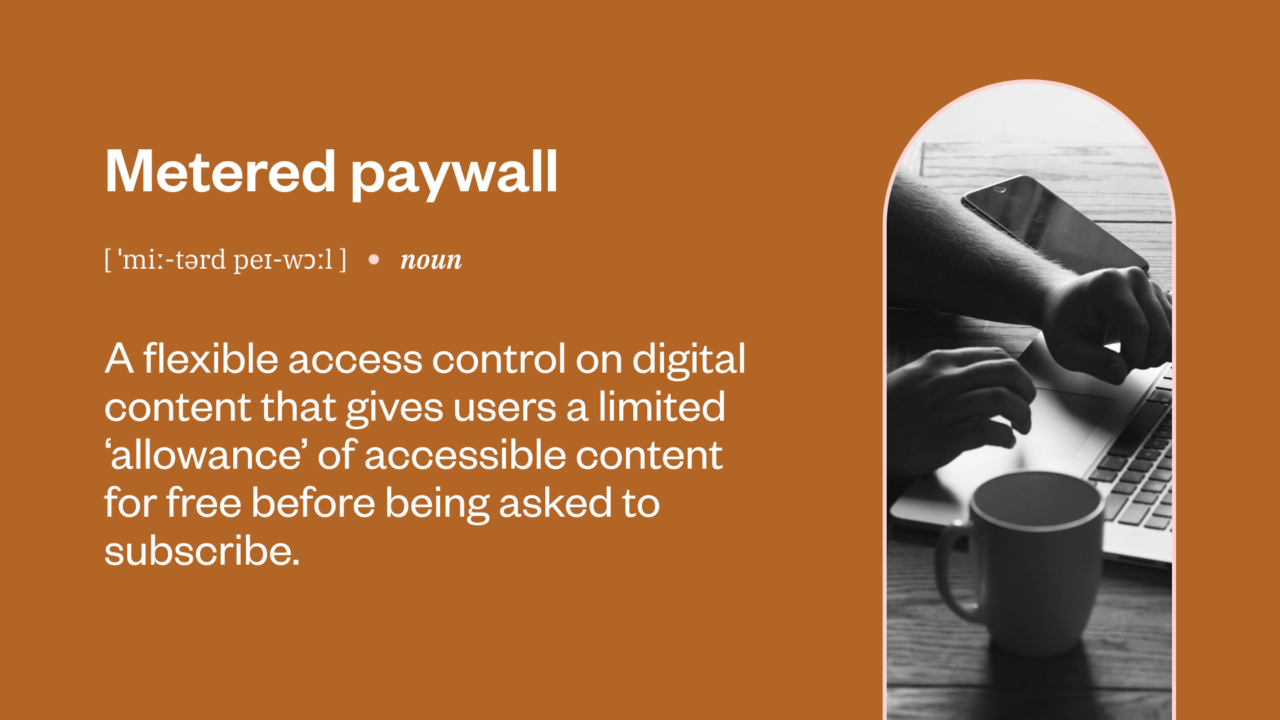Glossary Hub / Metered Paywall: Definition, Implementation, and Strategic Benefits
Metered Paywall: Definition, Implementation, and Strategic Benefits

For anyone in the digital publishing sphere right now, choosing the right paywall is a critical decision that impacts your customer acquisition, business growth, and revenue. Unfortunately, weighing up the features and practices of the different paywall models can only get you so far. Knowing and understanding your target audience is critical and should be the overwhelming factor considered when it comes to implementing a paywall.
Metered paywalls represent a happy medium between impermeable hard paywalls that might alienate new readers and simple free-for-alls that don’t drive conversion. For this reason, they are the second most used paywall model in the industry.
Effective subscription journeys have been built using metered paywalls over the last decade. The New York Times have used a metered system since 2011, tweaking the specifics of their model later in 2019. For The New Yorker, the move to a metered paywall led to a 61% increase in subscriptions. The first wave of digital transformation in publishing saw sites implementing paywalls to great effect. Now they are going a step further. The rise of powerful dynamic paywall solutions has persuaded many, including the NYT, to explore intelligent paywalls that do what metered paywalls do, but better.
In this article, we take a focused look at metered paywalls, how they work, and how to ascertain whether they are the right fit for your business. We also examine how metered paywalls are evolving, and whether they can retain their value in a world where intelligent paywall solutions are becoming the preferred option for many publishers.
What is a metered paywall?
Metered paywalls give your website visitors a limited ‘allowance’ of accessible content for free before being asked to subscribe.
Typically, this allowance will consist of a maximum number of articles that an unsubscribed reader can access in a certain amount of time. The industry average is five articles per month, but publishers have experimented with different limits, such as daily or yearly allowances.
If a user reaches their maximum allowance, they won’t be able to read any more of your content unless they pay to become a subscriber or wait until the time limit resets. Again, the price of a news subscription differs across industry and publication type, but the average monthly subscription price for metered paywalls in 2019 was £13.40.
Metered paywalls are customisable in the sense that digital publishers are free to set their ‘allowance’ as high or low as they feel fit. However, the allowance applies indiscriminately to all visitors to your site. So in this sense, metered paywalls are still ‘one-size-fits-all’ and don’t give you the ability to optimise subscription journeys to each individual reader.

How do metered paywalls work?
Setting up metered paywalls is relatively straightforward. As part of your digital marketing strategy, you give your readers a set allowance of content they’re able to access for free within a specific timeframe. It is entirely up to you to determine the number of articles you want to offer.
Though the allowance you set applies across the board to all non-subscribed readers, it’s essential to continually optimise and fine-tune your article limit to maximise conversion rates.
When it comes to metered paywalls, the most important and insightful metric is your stop rate. The ‘stop rate’ is the number of users who hit their maximum allowance and were therefore stopped from accessing any more content. If you’ve got a fairly low stop rate, this probably indicates that you’re being too generous with your allowance because readers are never reaching their limit and are therefore not being asked to subscribe.
Benefits of metered paywalls
Reach new audiences & casual readers
Perhaps the most significant advantage of using a metered paywall is that it allows new readers to try before they buy. This is important in giving potential subscribers a taste of what you’re offering and tempting them into committing to your publication.
Actionable data insights
Metered paywalls allow you to collect personalised insights about your subscribers and registered readers. You can then build a picture of their interactions and behaviours to hone their experience and offer greater personalisation. For example, you can learn about the kinds of devices that most readers are accessing your site from, where they’re coming to your site from, which browser they’re using, and their habits once they land on the site.
Having this data means you can build out and extrapolate patterns and trends that will help you shape your strategy moving forward to offer more personalised recommendations the next time they land on your site. In addition, you’ll be able to create content bundles that suit your audience and toggle content allowances to cater to audiences with different willingness to pay.
Downsides of metered paywalls
Porous or leaky
Unfortunately, metered paywalls are vulnerable to being ‘broken through’, meaning that users are able to bypass your content allowance. This is especially the case following the introduction of Chrome 76 in 2019, after which it became harder for digital publications to identify users circumventing their metered paywalls using private browsing or ‘incognito mode’. Though this doesn’t necessarily outweigh the benefits of implementing a metered paywall, it’s certainly something to keep in mind and track.
One-size-fits-all
Although perhaps not immediately obvious, metered paywalls are still a ‘one-size-fits-all’ strategy. Though casual readers can still consume the content of their choice, their limit is the same regardless of their behaviours or interactions. Plus, all users will hit the paywall at the same point rather than when they, individually, are the most primed for conversion.
In a digital landscape in which customisation and hyper-personalisation are becoming the expectation rather than an exception, some industry onlookers predict the death of one-size-fits-all approaches altogether in favour of intelligent solutions that fit to the user.
Best Practices for Metered Paywalls
Optimise your article allowance
As we mentioned earlier, optimising your article allowance to strike the right balance between being generous enough without offering too much is critical when it comes to metered paywalls. You should use your ‘stop rate’ to help refine your allowance, aiming for a stop rate of around 5 to 7%. If your stop rate is lower than this, it might indicate that your readers are enjoying too much for free or that engagement with your content is low. As a benchmark, the industry norm for a metered paywall is between 5 – 10 free articles offered before a stop.
Make your readers aware of their allowance
Part of making sure your metered paywall results in conversions is ensuring your customers are aware of their allowance. Reminding them that they’re enjoying an exclusive preview of your content is essential, as well as clearly outlining how many more articles they have left in their allowance.
Minimise barriers to entry
Make sure that the path to subscription is as smooth and straightforward as possible. Ensure that customers don’t have to jump through too many hoops in order to pay and subscribe.
Design & time your pop-ups right
Lastly, ensure that your pop-ups and subscription reminders are well designed and timed. For example, you should ensure that your pop-up doesn’t appear until the reader has had an opportunity to start reading the article. You should also encourage your readers to sign-up to a newsletter as this will allow you to start engaging with them via email too.
How to choose the right paywall for your business
Even if you like the sound of the metered paywall model, that doesn’t mean it’s necessarily the right choice for your publication. The reason? Not all publishers are built the same. The best paywall for your business will come down to your existing and target audience, as well as the size of your publication and whether you dominate a certain niche.
Hard paywalls work best for larger publications or publications that have a large established readership or dominate a certain niche. They are the most effective for publications whose brand name alone is enough to drive conversions.
Metered and Soft Paywalls represent a happy medium between exclusively premium content and tempting subscriptions by offering a preview of what you’ve got on offer. This is especially important for attracting newer readers. On average 0.5% of visitors that hit the paywall will convert, meaning that metered paywalls are the best option for sites that enjoy a large amount of traffic.
AI paywalls are arguably the next frontier of paywalls and will suit a large cross-section of businesses. Even bigger publications such as the New York Times have opted to harness the power of hyper-personalized, data-driven paywalls that create bespoke subscription funnels for each individual user.
Do metered paywalls have a future?
With developing technologies and the proliferation of data-driven solutions that optimise and individualise subscription funnels, it’s undeniable that conventional paywall models are falling to the wayside.
Metered paywalls represent a balanced halfway point between hard paywalls and free-for-alls, wherein you’re still able to offer up some of your content without offering too much. That being said, with the rise of intelligent paywalls that truly enhance each readers’ individual experience and prime them for subscription, it perhaps seems illogical not to opt for the most future-forward solution out there.
Read more about how Ai paywall solutions can drive your business forward here.